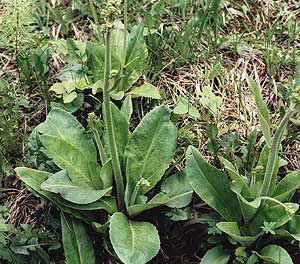
Swamp Saxifrage
The swamp saxifrage Saxifraga pensylvanica is not a well-known wild edible, despite the fact that it is common throughout the northeastern United States and adjacent Canada. The northern edge of its range extends roughly from northern Minnesota to Maine, and it is found as far south as Missouri and Virginia. Swamp saxifrage grows in wet meadows, brooksides, hardwood swamps, and along ponds and springs. It is most common in areas of partial shade. There is a similar edible species called lettuce saxifrage Saxifraga micranthidifolia (which I have never had the occasion to try) that grows along streams and brooks in the Appalachians from Pennsylvania to North Carolina (Peterson 1977, Angier 1974). Numerous other species of saxifrage grow in North America, including the Rocky Mountains, the Southeast, and the Arctic, but I do not know of their edibility status.
Swamp saxifrage is quite a distinct plant. It is a perennial rosette, with large (3"- 8"), blunt-tipped oval or lance-shaped leaves. Leaves grow from the base of the plant only; these often hug the ground, but other times they stand erect. The leaves are somewhat fuzzy and are toothed only slightly, if at all. Each rosette produces a single flower stalk in mid-spring, which branches near the top, bearing clusters of small, drab, greenish flowers with five petals. The flower stalk is stout, fuzzy, hollow, and quite fragile.
There are two edible parts of the swamp saxifrage plant. Chronologically, the first is the leaves, which can be used as a boiled potherb, or sparingly in salads. The leaves are somewhat bitter and I am not fond of them, but several of my students have liked them. These greens should be eaten very early in spring, before the flower stalk appears, or, if eaten later in spring, they should be selected from plants without flower stalks. Swamp saxifrage leaves, being rough and a little hairy, are good at clinging to sand; their habit of growing on stream edges often gives them sand to cling to. Carefully wash off this grit unless you want small teeth.
I first tried swamp saxifrage greens in late May some years ago and promptly dismissed it as an inedible wild edible. I thought that I should try the leaves at an earlier date to see if they would be more palatable, but I didn't get around to it for several years simply because there are so many wonderful wild greens in spring that it wasn't a high priority to try something that I was almost positive was going to be a disappointment. When I finally did remember to cook some younger leaves, from late April and early May, I tasted about a half dozen batches. Although they weren't as tough and bitter at this time as the older leaves I had tried, they were still nothing that I would go out of my way for. Not even ten feet. Especially not in spring.
Then one day my curiosity got the best of me and I decided to try the flower stalk. I had never heard of or read about this part being eaten, but it looked succulent and appetizing. Since I had never read any warning about the flower stalk, either, I assumed that it must be safe and gave it a taste. I selected a large stalk, upon which the flowering parts of the top were still in a tight cluster. When I broke it off at the base, it made a sound that told me it was crisp like celery. Liquid poured out of the hollow stem. The shoot smelled inviting, but mild. I began to crunch at the base of the stem, and it was delicious. There was the same bitterness of the leaves, only it was faint and pleasant, mixed with a light sweetness. The stem was crisp but juicier than any vegetable I had ever eaten. I discovered a unique new food that afternoon, one that is not only delicious but also has a superior texture.
Since then I have eaten swamp saxifrage flower stalks whenever I get the chance. I don't get the chance often, however, because the season is so short. There is only about two weeks in mid to late May that these shoots are in the proper stage for collecting. The stalk can be between eight and twenty-four inches tall - as long as the top has not yet begun to branch out and flower. If the stalks are harvested too late, they become tough and bitter. Even when the stalks are in their prime, the top third or so is sometimes less palatable. Some people find the fuzzy texture of the flower stalks unpleasant. I don't have much to say about that except that it doesn't bother me. These shoots can be chopped up and added to salad or soup. Cooking makes them extremely soft. I'm sure that one could find many good uses for this vegetable, both cooked and raw.
Swamp saxifrage is sometimes abundant; where it is rare or uncommon one should refrain from gathering it. Plucking a flower stalk does not kill the plant, but it eliminates its possibility for reproduction for the year. Besides humans, both black bears and deer feed on the flower stalks. Of course, it is wise to use moderation and never harvest these plants heavily in one area. That way one can rest assured that there will be plenty of succulent stalks next year.